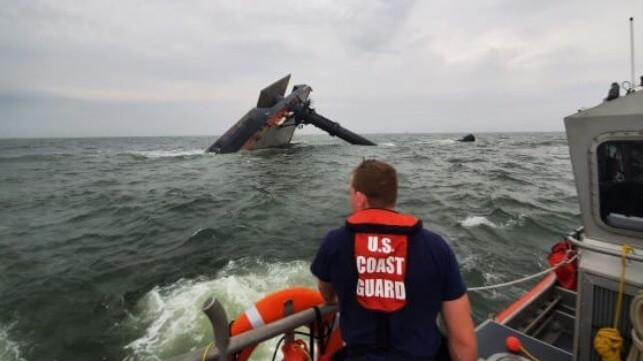After Seacor Power, NTSB Asks Industry to Buy Personal Locator Beacons

The National Transportation Safety Board has confirmed that severe winds led to the capsizing of the liftboat Seacor Power last year, resulting in the loss of 13 crewmembers. Winds over 80 knots and whiteout conditions were reported at the time the vessel went over.
On the afternoon of April 13, 2021, the liftboat Seacor Power got under way from Port Fourchon for an oil and gas lease site. The Coast Guard’s New Orleans navigational telex site was not working on the afternoon of the capsizing, so the crew of the Seacor Power did not receive a special marine warning about severe thunderstorms later in the day.
After 1500 hours, Seacor Power encountered a severe squall with extreme winds. The bridge team decided to lower the boat's legs to make contact with the seafloor and improve stability, and the mate tried to turn the vessel into the wind. During the turn, the Seacor Power heeled and capsized, coming to rest just before 1600 hours.
Winds in excess of design limits were the primary cause, NTSB determined. Other contributing factors may have included the fact that she was trimmed by the stern in excess of stability guidance; vessel leg movement; and the speed she had on when she initiated the turn.
Search and rescue at the scene was initially delayed by confusion over the vessel's location, due in part to inaccurate information provided by an employee of the operating company.
After the right position was identified, six crewmembers were rescued and six bodies recovered, including two from the interior of the vessel during a dive search. The remaining seven crewmembers were never found.
The mate was carrying a SART at the time he abandoned ship, but NTSB found that it was ineffective as a signaling device. The agency used the opportunity to take the U.S. Coast Guard to task over the absence of personal locator beacons (PLBs), which are not currently required safety equipment for the industry.
“We’ve been waiting five years for the Coast Guard to implement our recommendation on personal locator beacons — a call to action we’re renewing today for the fourth time,” said NTSB Chair Jennifer Homendy. “Mariners’ safety can’t wait, which is why I’m urging employers to invest in personal locator beacons for their crew . . . None of the people aboard the El Faro, the Scandies Rose, the Emmy Rose, or the Seacor Power had personal locator beacons. If they did, perhaps more of them would be with us today."
NTSB also called for higher stability requirements for newly-built liftboats, better planning and inter-agency coordination for air rescue operations, and better notification for mariners when a telex broadcasting station goes out of service.
It also called for the National Weather Service to determine whether it would be safe to lower the radar angles for coastal weather radars, which could help forecasters improve their predictions for local developments. A lack of low-altitude radar surveillance over the Louisiana coast prevented the National Weather Service's local office from spotting early signs of the extreme surface winds that hit Seacor Power.
